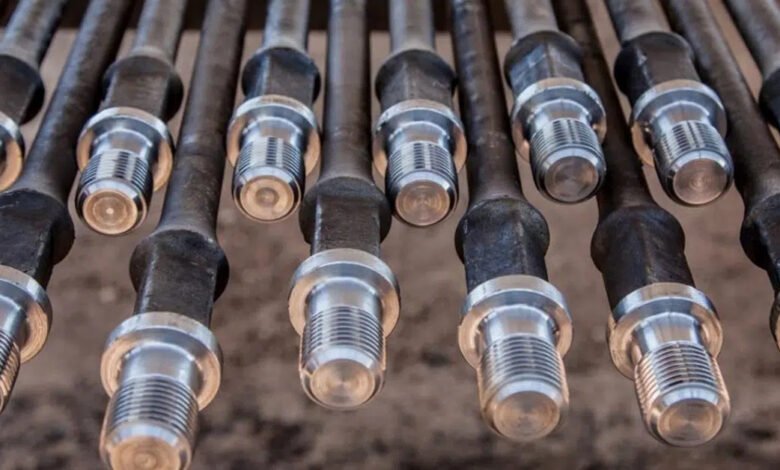Sucker Rods: The Complete Guide to Oil Well Pumping Systems

Introduction
The success of oil extraction operations often hinges on components that work tirelessly beneath the surface, far from public view. Among these critical elements, sucker rods stand as the backbone of artificial lift systems, connecting surface pumping units to downhole pumps hundreds or even thousands of feet below ground.
These slender steel connections enable the rhythmic pumping action that brings oil to the surface when natural reservoir pressure is insufficient. For oil and gas professionals, understanding sucker rod systems is essential for optimizing production, minimizing downtime, and ensuring long-term well profitability.
This comprehensive guide explores everything you need to know about sucker rods, from their basic function to advanced materials and emerging technologies that are shaping the future of artificial lift systems.
What Are Sucker Rods and Why Do They Matter?
Sucker rods are steel connecting rods that transfer mechanical energy from surface pumping units down to submersible pumps in oil wells. They form a continuous string that can extend thousands of feet into the wellbore, creating the mechanical linkage necessary for reciprocating pump systems.
The primary purpose of sucker rods is to provide the up-and-down motion required for beam pumps, also known as nodding donkeys or horsehead pumps. These systems are responsible for approximately 85% of artificial lift operations worldwide, making sucker rods one of the most widely used components in oil production.
Without reliable sucker rod systems, many wells would become uneconomical to operate. They enable producers to extract oil from mature fields, marginal wells, and reservoirs with declining natural pressure. The importance of these components becomes clear when considering that a single rod failure can shut down an entire well until repairs are completed.
Types of Sucker Rods: Understanding Your Options
Steel Sucker Rods
Traditional steel sucker rods remain the industry standard due to their proven reliability and cost-effectiveness. These rods are typically manufactured from high-grade carbon steel with specific metallurgical properties designed to withstand the cyclical stresses of pumping operations.
Steel rods come in standard lengths of 25 and 30 feet, with diameters ranging from 5/8 inch to 1 1/4 inches. The most common sizes are 3/4 inch, 7/8 inch, and 1 inch diameter rods, selected based on well depth, production requirements, and load considerations.
Continuous Sucker Rods
Continuous sucker rods represent a significant advancement in rod technology. Unlike conventional jointed rods, continuous rods consist of a single, uninterrupted steel wire that extends the entire length of the well. This design eliminates coupling connections, which are often the weakest points in traditional rod strings.
The absence of couplings reduces stress concentration points and minimizes the risk of failure. Continuous rods also offer improved fatigue resistance and can handle higher loads, making them ideal for deep wells or challenging operating conditions.
Specialized Sucker Rods
Modern applications have driven the development of specialized sucker rod materials and designs. Fiberglass rods offer corrosion resistance in harsh environments and can reduce the overall weight of the rod string. Carbon fiber composites provide exceptional strength-to-weight ratios, though at higher initial costs.
Coated rods featuring polymer or specialized metallic coatings help combat corrosion and reduce friction in challenging wellbore conditions. These specialized options allow operators to customize rod strings for specific well conditions and production goals.
Materials and Manufacturing: The Science Behind Sucker Rods
Composition and Metallurgy
High-quality sucker rods are manufactured from carefully selected carbon steel grades, typically containing 0.40-0.50% carbon content. This composition provides the optimal balance of strength, ductility, and fatigue resistance required for cyclical loading applications.
The steel undergoes precise heat treatment processes to achieve the desired mechanical properties. Proper heat treatment ensures uniform grain structure and optimal tensile strength while maintaining sufficient ductility to handle dynamic loads without premature failure.
Production Process
Manufacturing begins with steel bar stock that meets strict chemical composition requirements. The bars are heated and formed into the required rod diameter through hot rolling or forging processes. Critical attention is paid to surface finish, as surface imperfections can become stress concentration points leading to fatigue failures.
Threading is performed using specialized equipment that creates precise API (American Petroleum Institute) standard threads. These threads must meet exact specifications for proper coupling engagement and load transfer. Quality control measures include dimensional checking, surface inspection, and mechanical property testing to ensure each rod meets industry standards.
Applications in Oil and Gas: Where Sucker Rods Work
Pumping Systems Integration
Sucker rods function as the critical link between surface pumping units and downhole pumps in beam pumping systems. The surface unit, typically powered by an electric motor, converts rotary motion into reciprocating motion through a system of counterweights and walking beams.
This motion is transmitted through the sucker rod string to the downhole pump assembly, which includes a traveling valve, standing valve, and pump barrel. The coordinated action of these components creates the pressure differentials necessary to lift oil from the reservoir to the surface.
Well Types and Configurations
Sucker rod systems adapt to various well configurations, from shallow vertical wells to deep directional wells. In vertical applications, the rod string hangs relatively straight, simplifying load calculations and maintenance procedures. Directional wells present additional challenges, as rods must navigate wellbore curves while maintaining pumping efficiency.
Offshore applications require specialized considerations for marine environments, including enhanced corrosion protection and remote monitoring capabilities. Unconventional wells, such as those in shale formations, may require custom rod configurations to handle unique production profiles and wellbore geometries.
Installation and Maintenance: Best Practices for Success
Installation Procedures
Proper installation begins with careful planning and rod string design. Engineers must calculate loads, select appropriate rod sizes, and determine optimal taper schedules for varying well depths. Installation typically proceeds from bottom to top, with each rod joint carefully inspected before running into the well.
Torque specifications for coupling connections are critical for proper assembly. Under-torqued connections may fail under load, while over-torqued connections can damage threads or create stress concentrations. Specialized equipment ensures consistent and accurate torque application throughout the installation process.
Common Issues and Solutions
Rod failures typically occur at coupling connections, surface stress points, or areas of high wear. Regular inspection programs help identify potential problems before they result in costly failures. Visual inspection of surface rods, load monitoring, and production trend analysis provide early warning signs of developing issues.
Preventive maintenance includes regular rod string inspections, coupling retorquing, and replacement of worn components. Proper fluid management helps minimize corrosion, while optimized pumping speeds reduce fatigue stresses and extend rod life.
Advantages and Disadvantages: Weighing the Options
Benefits of Sucker Rod Systems
Sucker rod pumping systems offer proven reliability with decades of field experience across diverse operating conditions. They provide excellent control over production rates and can handle varying fluid properties, including high water cuts and moderate gas content.
The technology is well-understood by field personnel, with established maintenance procedures and readily available replacement parts. Operating costs are generally lower than other artificial lift methods, particularly for moderate-depth wells with steady production profiles.
Limitations and Challenges
Sucker rod systems have depth limitations, typically becoming less economical beyond 8,000-10,000 feet due to rod weight and load constraints. They require significant surface equipment footprints and may not be suitable for locations with space restrictions or environmental sensitivities.
The reciprocating motion can create vibration and noise issues, potentially limiting applications in populated areas. Rod failures, while manageable, can result in production downtime and workover costs that impact overall economics.
Future Trends: Innovation in Sucker Rod Technology
Advanced Materials
Research into advanced metallurgy continues to improve rod performance and longevity. New steel grades with enhanced fatigue resistance and corrosion properties are being developed specifically for challenging applications. Composite materials offer weight reduction benefits, though cost considerations currently limit widespread adoption.
Smart materials with embedded sensors represent an emerging frontier, potentially enabling real-time monitoring of rod stress, temperature, and other critical parameters. These innovations could revolutionize predictive maintenance and system optimization.
Digital Integration
Digital technologies are transforming sucker rod operations through advanced monitoring and control systems. Real-time data collection enables optimization of pumping parameters, predictive maintenance scheduling, and remote operation capabilities.
Machine learning algorithms analyze operational data to predict failures, optimize production, and reduce energy consumption. These technologies help operators maximize uptime while minimizing operational costs.
Frequently Asked Questions
What is the typical lifespan of sucker rods?
Sucker rod lifespan varies significantly based on operating conditions, but properly maintained rods in favorable environments can operate for 5-10 years or more. Harsh conditions involving corrosive fluids, high loads, or poor wellbore conditions may require more frequent replacement.
How do you calculate sucker rod loads?
Rod load calculations consider the weight of the rod string, fluid loads, dynamic forces from pumping action, and safety factors. Specialized software programs use well parameters, fluid properties, and operating conditions to determine optimal rod sizes and taper schedules.
Can sucker rods be repaired or must they be replaced?
Minor thread damage can sometimes be repaired through rethreading operations, but rods with body damage, significant wear, or fatigue cracking typically require replacement. The cost of repairs versus replacement often favors installing new rods to ensure reliability.
What causes sucker rod failures?
Common failure modes include fatigue from cyclical loading, corrosion from aggressive fluids, wear from sand production, and overload conditions. Proper rod string design, material selection, and operating practices help minimize failure risks.
Maximizing Success with Sucker Rod Systems
Sucker rods remain a cornerstone technology for oil production operations worldwide, providing reliable and economical artificial lift solutions for a wide range of applications. Understanding the various types, materials, and best practices enables operators to optimize system performance and minimize operational challenges.
Success with sucker rod systems requires careful attention to design, installation, and maintenance practices. As technology continues advancing, new materials and digital integration capabilities promise to enhance performance and reliability further.
For operators considering sucker rod implementations or seeking to optimize existing systems, consulting with experienced engineers and suppliers ensures access to the latest technologies and proven practices. The investment in proper system design and maintenance pays dividends through improved production, reduced downtime, and enhanced profitability.



